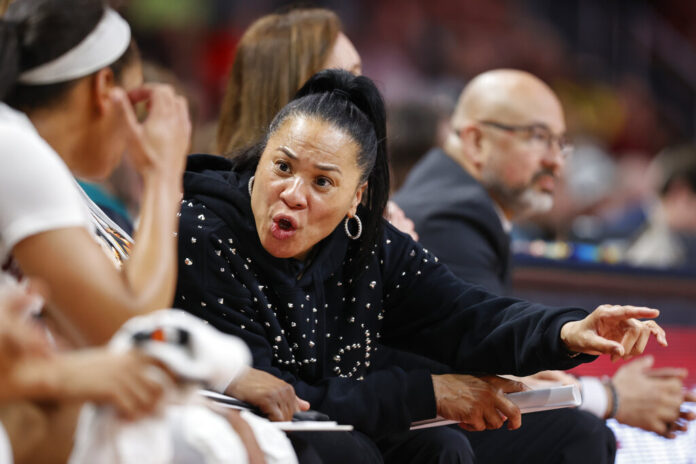
Women comprised less than half the head coaching positions and just over half of the assistant coaching spots for women’s college teams in the 2021-22 school year, according to a diversity study released Wednesday.
Women held just 42% of head coaching positions of women’s teams in NCAA Division I — a slight increase from the previous season — as well as 35.6% in Division II and 43.8% in Division III. For all three divisions combined, women filled 41.2% of head coaching positions and 50.3% of assistant coaching positions for women’s teams.
The annual report by the University of Central Florida’s Institute for Diversity and Ethics in Sport (TIDES) gave schools a “C” for overall racial and gender hiring practices. But TIDES director and report author Richard Lapchick called the representation of women coaches in women’s sports “the most depressing statistic that we report every year.”
“It doesn’t even make any sense to me, that nearly 60% of women’s teams are coached by men 50 years after the passage of Title IX,” Lapchick said, referring to the federal law best known for its role in gender equity in athletics and preventing sexual harassment on campuses.
A month earlier, a separate TIDES report showed that the number of women working as athletic directors at Football Bowl Subdivision programs dropped from 13 to 10 in 2022, with only six of them in Power Five conferences (Duke, Missouri, Pittsburgh, Vanderbilt, Virginia and Washington).
From a racial hiring and employment standpoint for coaches, white people continue to fill the vast majority of head coaching positions at all levels.
But Wednesday’s report did note slight increases in the percentages of Black head coaches of men’s teams between the 2020-21 school year to the 2021-22 school year — 9.9% in Division I (up from 9%), 6.6% in Division II (up from 6.2%) and 6.3% in Division III (up from 5.9%).
White people hold 84.1% of the men’s head coaching positions in Division I, 85.2% in Division II and 89% in Division III. For women’s teams, it’s 80.6% white head coaches in Division I, 84.5% in Division II and 88.1% in Division III. Those figures represent slight decreases in all three divisions for both men’s and women’s teams.
In all three divisions, white people made up 70.6% of the men’s basketball head coaches, 86.8% of the football head coaches and 92.8% of the baseball head coaches.
Lapchick noted that the lack of racial and gender diversity within the athletic director ranks could play a part in the lack of diversity among coaches overall, since athletic directors do much of the hiring.
“I’m not saying they’re all racist or sexist,” Lapchick said. “I’m just saying that the likelihood is they’re going to continue to move within the circles that they’ve moved in, and that’s overwhelmingly going to be white men.”
Almost 25% of Division I men’s basketball head coaches were Black, up from 24.3% in 2020-21 but short of the record high of 25.2% in 2005-06. Black student-athletes made up 52.4% of the Division I men’s basketball rosters.
“An ideal goal … is to be representative of the student-athletes that are playing, or at least close to that,” Lapchick said. “We’re not close to that.”
TIDES gave the the NCAA’s national office a B-minus for racial diversity and an A-plus for gender diversity in senior leadership and professional positions.
“Our marks are reflective of an intentional effort to develop an inclusive culture that recognizes and values organizational excellence,” said Felicia Martin, the NCAA senior vice president of inclusion, education and community engagement. “By now, the importance of diversity in leadership is clear. When organizations embrace diversity, equity and inclusion, the data supports better company culture.”
Lapchick said the next step is to get NCAA member schools to have a similar level of diversity as the national office.
“It’s a parallel to pro sports, where the league offices all do well, and then with the individual teams, the grades go down pretty dramatically,” Lapchick said. “If the schools follow the national office’s hiring practices, we’d have much more diverse leadership positions, including coaches, at the college level.”


